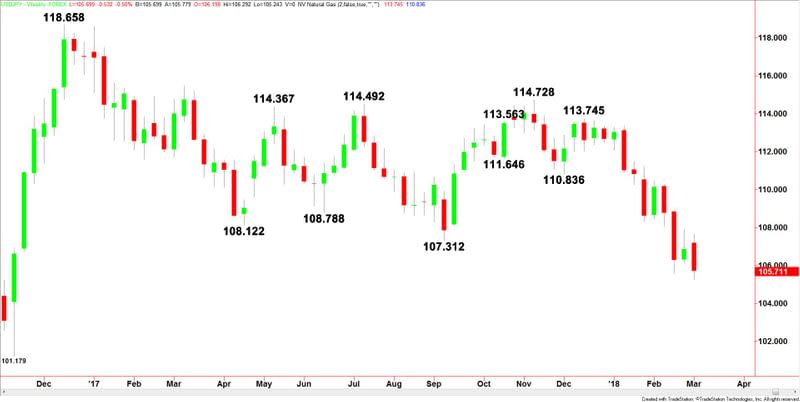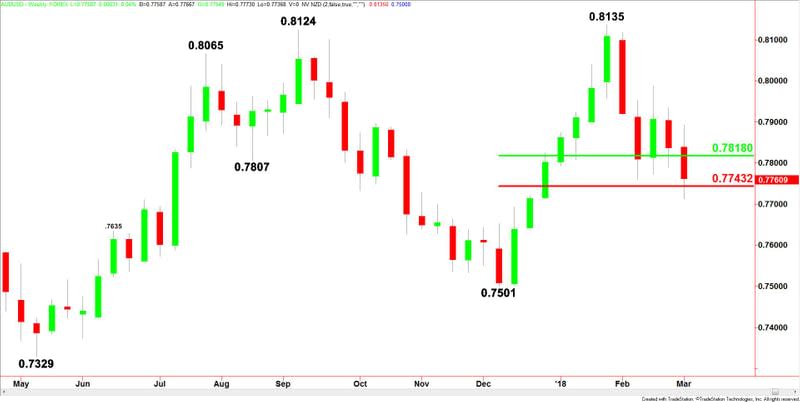Flight-to-Safety Buying Crushes USD/JPY
The U.S. Dollar finished higher against a basket of currencies in a week highlighted by a couple of major events that led to increased volatility. The first event helped drive the index to its highest level since January 12. The second event helped stop the rally while erasing most of the market’s earlier gains.
March U.S. Dollar Index futures settled the week at 89.906, up 0.098 or 0.11%.

Early in the week, the U.S. Dollar picked up strength in reaction to a sharp rise in U.S. Treasury yields. Yields were boosted by hawkish comments from Fed Chair Jerome Powell who said the central bank could raise interest rates three or more time during the course of this year to prevent the U.S. economy from overheating.
“We’ve seen some data that in my case will add some confidence to my view that inflation is moving up to target,” Powell told lawmakers on Tuesday. “We’ve also seen continued strength around the globe. And we’ve seen fiscal policy become more stimulative. So I think each of us is going to be taking the developments since the December meeting.”
The dollar reached its peak on Thursday before getting slammed into the close and on Friday. The sell-off was fueled by President Trump’s announcements of tariffs on steel and aluminum. The news raised fears of a trade war and worries over the return of robust inflation.
Trump said the U.S. will implement a 25 percent tariff on steel imports and a 10 percent tariff on aluminum imports this week. The surprise announcement sent stocks reeling, with the Dow losing about 500 points over two session. It also raised concern that Canada, Asia and Europe may implement retaliatory tariffs on U.S. exports.
In other news, U.S. Core Durable Goods Orders fell 0.3%. However, Consumer Confidence came in higher than expected at 130.8. Preliminary GDP met expectations and ISM Manufacturing PMI beat the forecast.

USD/JPY
The Dollar/Yen closed sharply lower last week after posting a volatile two-sided trade. The dollar picked up strength early in the week as the spread between U.S. government bond yields and Japanese government bond yields widened due to hawkish comments from Fed Chair Powell.
The USD/JPY settled at 105.711, down 1.136 or -1.06%.
Flight-to-safety buying helped put in a top in the USD/JPY as investors sought shelter in the Japanese Yen due to sell-off in U.S. equity markets. The selling pressure grew stronger after Trump’s tariff announcement.
The Yen also rallied after Bank of Japan Governor Haruhiko Kuroda surprised currency markets by saying the central bank would consider an exit from its ultra-easy monetary policy if it met its inflation target in the year ending in March 2020.

AUD/USD and NZD/USD
Rising U.S. Treasury yields and hawkish testimony by Fed Chair Jerome Powell put pressure on the Australian and New Zealand Dollars most of the week before Trump’s surprise tariff announcement reversed the course of the U.S. Dollar.
The AUD/USD settled the week at .7761, down 0.0075 or -0.96% and the NZD/USD finished at .7238, down 0.0052 or -0.72%.
In other news, ANZ Business Confidence was -19.0, an improvement from the previous -37.8. A report on Australian Private Capital Expenditure showed a 0.2% decline versus a 1.0% forecast. The previous month was revised to 1.9%.
This article was originally posted on FX Empire

 Yahoo Finance
Yahoo Finance 